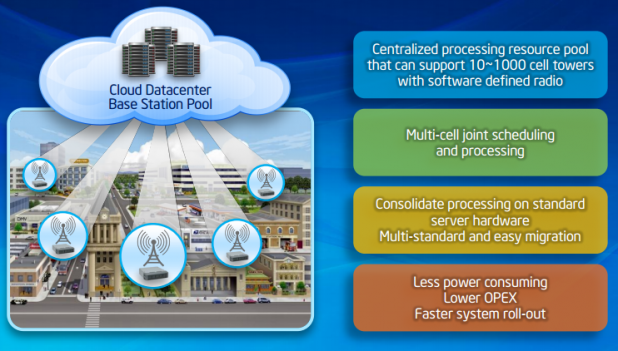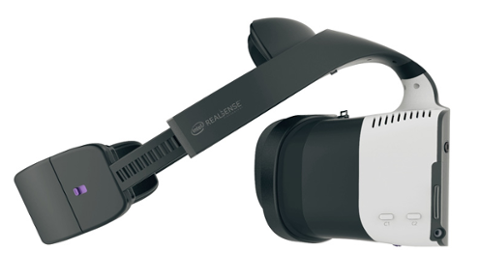 Intel and China Mobile believe the C-RAN technology can save both money and power.[/caption] Intel took a step forward on its quest to abstract the hardware found in a cellular base station, consolidating the workloads inside a modern data center. At the Intel Developer Forum on Thursday, Intel chief technical officer Justin Rattner demonstrated workloads being shunted back and forth to maximize the available computing resources on the Cloud Radio Access Network (C-RAN) being jointly developed with China Mobile. Last year, Intel showed off C-RAN, a base-station stack running on top of an Intel “Sandy Bridge” chip, demonstrating that it was "possible to replace custom and mostly proprietary hardware radios at the cell sites with software running on standard server hardware in the data center," Rattner said. The argument? With software-defined radio running on hundreds or even thousands of IA-based servers, a modern data center can replace much of the computing hardware traditionally installed in base station towers scattered across a wide-area cellular network. That, in turn, can save wireless operators a bundle. With C-RAN, centralized processing, collaborative radio, and also cloud computing all work together. It’s been a slow road for Intel and its partner, China Mobile, the world’s largest carrier. (China Mobile struck a similar partnership with Alcatel-Lucent in 2011, an early proponent of the C-RAN concept.) But the need is great: Chih-Lin I, the chief scientist for China Mobile, appeared on stage at IDF to reveal that the company has 900,000 existing 2G/3G base stations. And with a shift to LTE in the offing, China Mobile plans to add 20,000 base stations this year, then 200,000 in 2013, and 350,000 in 2014. China Mobile also has 680 million subscribers to serve. And with the large number of cell sites, China Mobile’s power consumption last year was about 30 billion kilowatt hours of power, and 70 percent of that was in the base stations, I said. Interference is also becoming a problem, she said. “We're not very happy with the fact that our revenue is not growing proportionally, so we need to be much more cost-effective,” I said. At IDF this week, Intel showed off a pair of LTE base station stacks running on a Core i7 processor. The simulation emulated video workloads, which grew as more “subscribers” signed on to the system and began using it. Intel’s demo showed that that workload could be offloaded to another server. The demo also showed that lightly loaded base-station stacks could be consolidated, so that servers could be turned off to save power. Next year, Rattner said the target would be virtualization, almost a necessity before the technology could be deployed in the field. The target is 100 virtualized base stations, he said. To reach that point, however, Intel needs to continue working on the C-RAN architecture optimization, support different loading levels for different scenarios. China Mobile, meanwhile, continues to add pieces to its vision of the C-RAN architecture, which is expected to support multiple technologies, including GSM, TD-SCDMA and LTE TDD as well as LTE TDD-Advanced. China Mobile recently signed Agilent to create tests for the mobile access architectures; Huawei and ZTE are expected to provide the C-RAN hardware. Image: Intel
Intel and China Mobile believe the C-RAN technology can save both money and power.[/caption] Intel took a step forward on its quest to abstract the hardware found in a cellular base station, consolidating the workloads inside a modern data center. At the Intel Developer Forum on Thursday, Intel chief technical officer Justin Rattner demonstrated workloads being shunted back and forth to maximize the available computing resources on the Cloud Radio Access Network (C-RAN) being jointly developed with China Mobile. Last year, Intel showed off C-RAN, a base-station stack running on top of an Intel “Sandy Bridge” chip, demonstrating that it was "possible to replace custom and mostly proprietary hardware radios at the cell sites with software running on standard server hardware in the data center," Rattner said. The argument? With software-defined radio running on hundreds or even thousands of IA-based servers, a modern data center can replace much of the computing hardware traditionally installed in base station towers scattered across a wide-area cellular network. That, in turn, can save wireless operators a bundle. With C-RAN, centralized processing, collaborative radio, and also cloud computing all work together. It’s been a slow road for Intel and its partner, China Mobile, the world’s largest carrier. (China Mobile struck a similar partnership with Alcatel-Lucent in 2011, an early proponent of the C-RAN concept.) But the need is great: Chih-Lin I, the chief scientist for China Mobile, appeared on stage at IDF to reveal that the company has 900,000 existing 2G/3G base stations. And with a shift to LTE in the offing, China Mobile plans to add 20,000 base stations this year, then 200,000 in 2013, and 350,000 in 2014. China Mobile also has 680 million subscribers to serve. And with the large number of cell sites, China Mobile’s power consumption last year was about 30 billion kilowatt hours of power, and 70 percent of that was in the base stations, I said. Interference is also becoming a problem, she said. “We're not very happy with the fact that our revenue is not growing proportionally, so we need to be much more cost-effective,” I said. At IDF this week, Intel showed off a pair of LTE base station stacks running on a Core i7 processor. The simulation emulated video workloads, which grew as more “subscribers” signed on to the system and began using it. Intel’s demo showed that that workload could be offloaded to another server. The demo also showed that lightly loaded base-station stacks could be consolidated, so that servers could be turned off to save power. Next year, Rattner said the target would be virtualization, almost a necessity before the technology could be deployed in the field. The target is 100 virtualized base stations, he said. To reach that point, however, Intel needs to continue working on the C-RAN architecture optimization, support different loading levels for different scenarios. China Mobile, meanwhile, continues to add pieces to its vision of the C-RAN architecture, which is expected to support multiple technologies, including GSM, TD-SCDMA and LTE TDD as well as LTE TDD-Advanced. China Mobile recently signed Agilent to create tests for the mobile access architectures; Huawei and ZTE are expected to provide the C-RAN hardware. Image: Intel Intel Moves Forward on Virtual Base Station
[caption id="attachment_4485" align="aligncenter" width="618"] Intel and China Mobile believe the C-RAN technology can save both money and power.[/caption] Intel took a step forward on its quest to abstract the hardware found in a cellular base station, consolidating the workloads inside a modern data center. At the Intel Developer Forum on Thursday, Intel chief technical officer Justin Rattner demonstrated workloads being shunted back and forth to maximize the available computing resources on the Cloud Radio Access Network (C-RAN) being jointly developed with China Mobile. Last year, Intel showed off C-RAN, a base-station stack running on top of an Intel “Sandy Bridge” chip, demonstrating that it was "possible to replace custom and mostly proprietary hardware radios at the cell sites with software running on standard server hardware in the data center," Rattner said. The argument? With software-defined radio running on hundreds or even thousands of IA-based servers, a modern data center can replace much of the computing hardware traditionally installed in base station towers scattered across a wide-area cellular network. That, in turn, can save wireless operators a bundle. With C-RAN, centralized processing, collaborative radio, and also cloud computing all work together. It’s been a slow road for Intel and its partner, China Mobile, the world’s largest carrier. (China Mobile struck a similar partnership with Alcatel-Lucent in 2011, an early proponent of the C-RAN concept.) But the need is great: Chih-Lin I, the chief scientist for China Mobile, appeared on stage at IDF to reveal that the company has 900,000 existing 2G/3G base stations. And with a shift to LTE in the offing, China Mobile plans to add 20,000 base stations this year, then 200,000 in 2013, and 350,000 in 2014. China Mobile also has 680 million subscribers to serve. And with the large number of cell sites, China Mobile’s power consumption last year was about 30 billion kilowatt hours of power, and 70 percent of that was in the base stations, I said. Interference is also becoming a problem, she said. “We're not very happy with the fact that our revenue is not growing proportionally, so we need to be much more cost-effective,” I said. At IDF this week, Intel showed off a pair of LTE base station stacks running on a Core i7 processor. The simulation emulated video workloads, which grew as more “subscribers” signed on to the system and began using it. Intel’s demo showed that that workload could be offloaded to another server. The demo also showed that lightly loaded base-station stacks could be consolidated, so that servers could be turned off to save power. Next year, Rattner said the target would be virtualization, almost a necessity before the technology could be deployed in the field. The target is 100 virtualized base stations, he said. To reach that point, however, Intel needs to continue working on the C-RAN architecture optimization, support different loading levels for different scenarios. China Mobile, meanwhile, continues to add pieces to its vision of the C-RAN architecture, which is expected to support multiple technologies, including GSM, TD-SCDMA and LTE TDD as well as LTE TDD-Advanced. China Mobile recently signed Agilent to create tests for the mobile access architectures; Huawei and ZTE are expected to provide the C-RAN hardware. Image: Intel
Intel and China Mobile believe the C-RAN technology can save both money and power.[/caption] Intel took a step forward on its quest to abstract the hardware found in a cellular base station, consolidating the workloads inside a modern data center. At the Intel Developer Forum on Thursday, Intel chief technical officer Justin Rattner demonstrated workloads being shunted back and forth to maximize the available computing resources on the Cloud Radio Access Network (C-RAN) being jointly developed with China Mobile. Last year, Intel showed off C-RAN, a base-station stack running on top of an Intel “Sandy Bridge” chip, demonstrating that it was "possible to replace custom and mostly proprietary hardware radios at the cell sites with software running on standard server hardware in the data center," Rattner said. The argument? With software-defined radio running on hundreds or even thousands of IA-based servers, a modern data center can replace much of the computing hardware traditionally installed in base station towers scattered across a wide-area cellular network. That, in turn, can save wireless operators a bundle. With C-RAN, centralized processing, collaborative radio, and also cloud computing all work together. It’s been a slow road for Intel and its partner, China Mobile, the world’s largest carrier. (China Mobile struck a similar partnership with Alcatel-Lucent in 2011, an early proponent of the C-RAN concept.) But the need is great: Chih-Lin I, the chief scientist for China Mobile, appeared on stage at IDF to reveal that the company has 900,000 existing 2G/3G base stations. And with a shift to LTE in the offing, China Mobile plans to add 20,000 base stations this year, then 200,000 in 2013, and 350,000 in 2014. China Mobile also has 680 million subscribers to serve. And with the large number of cell sites, China Mobile’s power consumption last year was about 30 billion kilowatt hours of power, and 70 percent of that was in the base stations, I said. Interference is also becoming a problem, she said. “We're not very happy with the fact that our revenue is not growing proportionally, so we need to be much more cost-effective,” I said. At IDF this week, Intel showed off a pair of LTE base station stacks running on a Core i7 processor. The simulation emulated video workloads, which grew as more “subscribers” signed on to the system and began using it. Intel’s demo showed that that workload could be offloaded to another server. The demo also showed that lightly loaded base-station stacks could be consolidated, so that servers could be turned off to save power. Next year, Rattner said the target would be virtualization, almost a necessity before the technology could be deployed in the field. The target is 100 virtualized base stations, he said. To reach that point, however, Intel needs to continue working on the C-RAN architecture optimization, support different loading levels for different scenarios. China Mobile, meanwhile, continues to add pieces to its vision of the C-RAN architecture, which is expected to support multiple technologies, including GSM, TD-SCDMA and LTE TDD as well as LTE TDD-Advanced. China Mobile recently signed Agilent to create tests for the mobile access architectures; Huawei and ZTE are expected to provide the C-RAN hardware. Image: Intel
 Intel and China Mobile believe the C-RAN technology can save both money and power.[/caption] Intel took a step forward on its quest to abstract the hardware found in a cellular base station, consolidating the workloads inside a modern data center. At the Intel Developer Forum on Thursday, Intel chief technical officer Justin Rattner demonstrated workloads being shunted back and forth to maximize the available computing resources on the Cloud Radio Access Network (C-RAN) being jointly developed with China Mobile. Last year, Intel showed off C-RAN, a base-station stack running on top of an Intel “Sandy Bridge” chip, demonstrating that it was "possible to replace custom and mostly proprietary hardware radios at the cell sites with software running on standard server hardware in the data center," Rattner said. The argument? With software-defined radio running on hundreds or even thousands of IA-based servers, a modern data center can replace much of the computing hardware traditionally installed in base station towers scattered across a wide-area cellular network. That, in turn, can save wireless operators a bundle. With C-RAN, centralized processing, collaborative radio, and also cloud computing all work together. It’s been a slow road for Intel and its partner, China Mobile, the world’s largest carrier. (China Mobile struck a similar partnership with Alcatel-Lucent in 2011, an early proponent of the C-RAN concept.) But the need is great: Chih-Lin I, the chief scientist for China Mobile, appeared on stage at IDF to reveal that the company has 900,000 existing 2G/3G base stations. And with a shift to LTE in the offing, China Mobile plans to add 20,000 base stations this year, then 200,000 in 2013, and 350,000 in 2014. China Mobile also has 680 million subscribers to serve. And with the large number of cell sites, China Mobile’s power consumption last year was about 30 billion kilowatt hours of power, and 70 percent of that was in the base stations, I said. Interference is also becoming a problem, she said. “We're not very happy with the fact that our revenue is not growing proportionally, so we need to be much more cost-effective,” I said. At IDF this week, Intel showed off a pair of LTE base station stacks running on a Core i7 processor. The simulation emulated video workloads, which grew as more “subscribers” signed on to the system and began using it. Intel’s demo showed that that workload could be offloaded to another server. The demo also showed that lightly loaded base-station stacks could be consolidated, so that servers could be turned off to save power. Next year, Rattner said the target would be virtualization, almost a necessity before the technology could be deployed in the field. The target is 100 virtualized base stations, he said. To reach that point, however, Intel needs to continue working on the C-RAN architecture optimization, support different loading levels for different scenarios. China Mobile, meanwhile, continues to add pieces to its vision of the C-RAN architecture, which is expected to support multiple technologies, including GSM, TD-SCDMA and LTE TDD as well as LTE TDD-Advanced. China Mobile recently signed Agilent to create tests for the mobile access architectures; Huawei and ZTE are expected to provide the C-RAN hardware. Image: Intel
Intel and China Mobile believe the C-RAN technology can save both money and power.[/caption] Intel took a step forward on its quest to abstract the hardware found in a cellular base station, consolidating the workloads inside a modern data center. At the Intel Developer Forum on Thursday, Intel chief technical officer Justin Rattner demonstrated workloads being shunted back and forth to maximize the available computing resources on the Cloud Radio Access Network (C-RAN) being jointly developed with China Mobile. Last year, Intel showed off C-RAN, a base-station stack running on top of an Intel “Sandy Bridge” chip, demonstrating that it was "possible to replace custom and mostly proprietary hardware radios at the cell sites with software running on standard server hardware in the data center," Rattner said. The argument? With software-defined radio running on hundreds or even thousands of IA-based servers, a modern data center can replace much of the computing hardware traditionally installed in base station towers scattered across a wide-area cellular network. That, in turn, can save wireless operators a bundle. With C-RAN, centralized processing, collaborative radio, and also cloud computing all work together. It’s been a slow road for Intel and its partner, China Mobile, the world’s largest carrier. (China Mobile struck a similar partnership with Alcatel-Lucent in 2011, an early proponent of the C-RAN concept.) But the need is great: Chih-Lin I, the chief scientist for China Mobile, appeared on stage at IDF to reveal that the company has 900,000 existing 2G/3G base stations. And with a shift to LTE in the offing, China Mobile plans to add 20,000 base stations this year, then 200,000 in 2013, and 350,000 in 2014. China Mobile also has 680 million subscribers to serve. And with the large number of cell sites, China Mobile’s power consumption last year was about 30 billion kilowatt hours of power, and 70 percent of that was in the base stations, I said. Interference is also becoming a problem, she said. “We're not very happy with the fact that our revenue is not growing proportionally, so we need to be much more cost-effective,” I said. At IDF this week, Intel showed off a pair of LTE base station stacks running on a Core i7 processor. The simulation emulated video workloads, which grew as more “subscribers” signed on to the system and began using it. Intel’s demo showed that that workload could be offloaded to another server. The demo also showed that lightly loaded base-station stacks could be consolidated, so that servers could be turned off to save power. Next year, Rattner said the target would be virtualization, almost a necessity before the technology could be deployed in the field. The target is 100 virtualized base stations, he said. To reach that point, however, Intel needs to continue working on the C-RAN architecture optimization, support different loading levels for different scenarios. China Mobile, meanwhile, continues to add pieces to its vision of the C-RAN architecture, which is expected to support multiple technologies, including GSM, TD-SCDMA and LTE TDD as well as LTE TDD-Advanced. China Mobile recently signed Agilent to create tests for the mobile access architectures; Huawei and ZTE are expected to provide the C-RAN hardware. Image: Intel 

